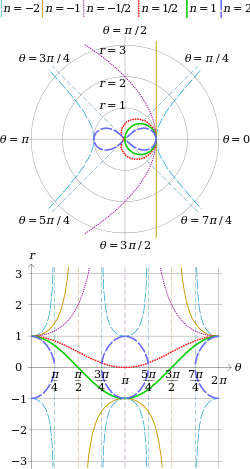Sinusoidal spiral

In geometry, the sinusoidal spirals are a family of curves defined by the equation in polar coordinates
where a is a nonzero constant and n is a rational number other than 0. With a rotation about the origin, this can also be written
The term "spiral" is a misnomer, because they are not actually spirals, and often have a flower-like shape. Many well known curves are sinusoidal spirals including:
- Equilateral hyperbola (n = −2)
- Line (n = −1)
- Parabola (n = −1/2)
- Tschirnhausen cubic (n = −1/3)
- Cayley's sextet (n = 1/3)
- Cardioid (n = 1/2)
- Circle (n = 1)
- Lemniscate of Bernoulli (n = 2)
The curves were first studied by Colin Maclaurin.
Equations
Differentiating
and eliminating a produces a differential equation for r and θ:
- .
Then
which implies that the polar tangential angle is
and so the tangential angle is
- .
(The sign here is positive if r and cos nθ have the same sign and negative otherwise.)
The unit tangent vector,
- ,
has length one, so comparing the magnitude of the vectors on each side of the above equation gives
- .
In particular, the length of a single loop when is:
The curvature is given by
- .
Properties
The inverse of a sinusoidal spiral with respect to a circle with center at the origin is another sinusoidal spiral whose value of n is the negative of the original curve's value of n. For example, the inverse of the lemniscate of Bernoulli is a hyperbola.
The isoptic, pedal and negative pedal of a sinusoidal spiral are different sinusoidal spirals.
One path of a particle moving according to a central force proportional to a power of r is a sinusoidal spiral.
When n is an integer, and n points are arranged regularly on a circle of radius a, then the set of points so that the geometric mean of the distances from the point to the n points is a sinusoidal spiral. In this case the sinusoidal spiral is a polynomial lemniscate
| Wikimedia Commons has media related to Sinusoidal spiral. |
References
- Yates, R. C.: A Handbook on Curves and Their Properties, J. W. Edwards (1952), "Spiral" p. 213–214
- "Sinusoidal spiral" at www.2dcurves.com
- "Sinusoidal Spirals" at The MacTutor History of Mathematics
- "Spirale Sinusoïdale" at Encyclopédie des Formes Mathématiques Remarquables
- Weisstein, Eric W. "Sinusoidal Spiral". MathWorld.